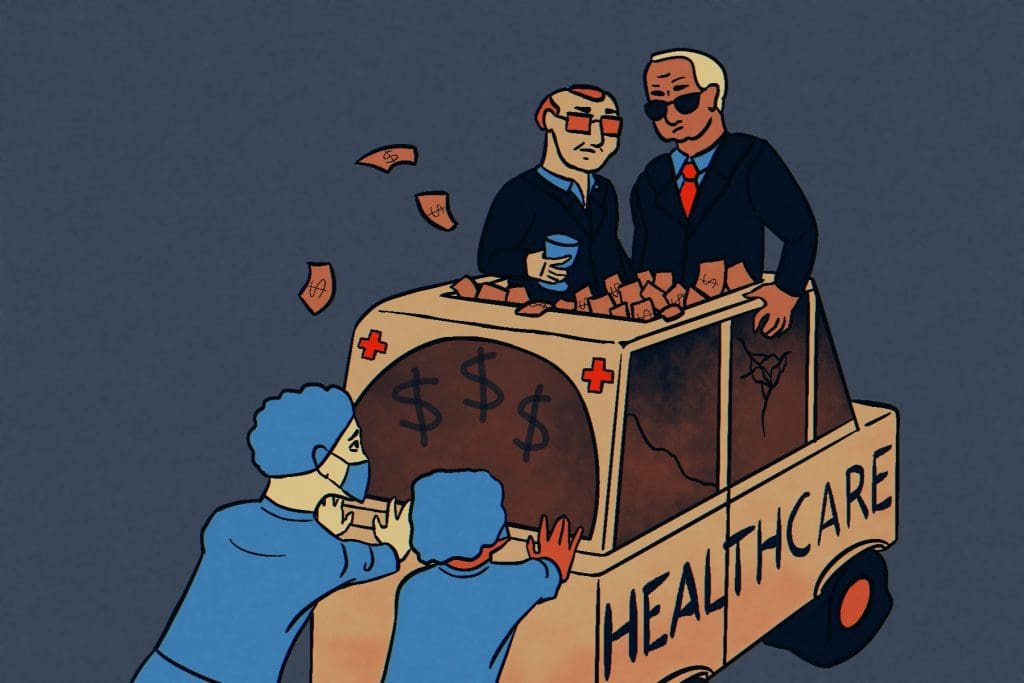Illustration by Xanthea Carlson.
“What would health care look like if it was a car,” I asked nurses.
It was a game they were curious enough to play. Metaphors are critical to perception. They help us frame and understand complex and overwhelming issues.
The car would be a limousine… and the check engine light would be on constantly because nobody could fix it.
The car would use premium gasoline – and would get 1 mile per gallon.
No one would be in the driver’s seat, so the car would aimlessly travel to places of illness and disease – always arriving too late.
The doctors would probably be in the middle seat, while the investors would sit in the back seat sipping champagne.
Nurses would be pushing the car – many dropping from the exhaust(ion)!
Politicians would talk incessantly about why we needed a limo, while policy leaders would endlessly debate which color to paint the rusted out frame to make it look better.
What would you add or change?
So far, the current political narrative surrounding health care reform has been limited to three different limousines: remove and replace the Patient Protection Affordable Care Act by implementing Universal Care; remove the PPACA; or incrementally improve the existing PPACA. But what if there was another solution that could put nurses in the driver’s seat?
What if health care was a bus? Using this metaphor, people could easily get on and off and everyone would pay the same fare. Nurses would establish the routes and administer the stops. People would get to know and trust the bus drivers on their locally run regular routes which would also stop to address the social determinants of health like housing, child care and food. This is the public utility model.
Defining Public Utility
By definition, a public utility enterprise is one that provides certain classes of vital services to the public like sewer, water, heat and sanitation.1 In 2016 there was an outcry that broadband internet also fall into this category. Why not health?
History has already paved the way. The Public Utility Holding Corporation Act of 1935 was enacted because electricity was viewed as a commodity to be enjoyed by some, but not a vital public service available to all. The inequities became too obvious for leaders to ignore (sound familiar?). Electricity had many of the same issues we are facing in health care: cost, distribution of resources, access and fragmentation. Franklin D. Roosevelt set legal precedence on over-inflated, ineffective services when he created the public utility solution.2
Nurses are suffering and leaving,3 profits are soaring,4 providers are stressed and depressed,5 and various regions have almost no services.6 Our outcomes are tragic and humiliating compared to other nations,7 and the rural system is disintegrating as more and more hospitals close.8 Add to this the shortage of 75,000 primary care physicians and 504,000 nurses by 2025 and we are headed for disaster.9
Health Care as a Public Utility?
After years of research, Dr. John Silver has proposed the public utility model for public health care delivery.10 State-based systems would be led by interdisciplinary regional councils with nurse practitioner, or physician led clinics, so that every American would have a primary care provider onboard – as recommended by a recent advisory panel.11 Financing for this model would be provided by individuals, as well as state and federal funding.
The public utility model is familiar, apolitical, regionally administered, equitable, and has a vested interest in creating healthy communities. Nothing will significantly change for nurses until we create a new structure. The greatest innovation of all is a radically new system that puts nurses in the driver’s seat where they belong – where they can use the full extent of their skills and knowledge to lead Americans to a state of health and well-being.
Comparison of Models of Healthcare Practice
| Current Biomedical Model | Public Utility Model |
| Focus is on diagnosis and treatment of disease | Focus is on Wellness and disease prevention |
| Top focus is on maintaining profitability to exist | Thrives financially by keeping people well and out of the hospital |
| Patient is encouraged to rely on professional for healthcare needs | Patient is empowered and encouraged to promote his/her own health |
| Autocratic, physician-driven model: Hierarchical relationships are valued and encouraged | Nurse-driven model: All members of the team work together in an interdisciplinary approach |
| The professional is the authority; the one in charge | The professional serves as a therapeutic partner |
| Healthcare costs are expected to consumer $3.5 trillion, and continue upwards | Cost efficiency: would save over 30% of current healthcare costs |
| Health outcomes are poor – the US ranks 37th among industrialized nations; 45MM Americans under- or uninsured | Health outcomes would improve: Equitable and positive outcomes, equitable access to all in community |
| No transparency or accountability in current system | Social accountability and a mandate for direct public reporting |
| System is responsible for health | Shared responsibility for population health with business, communities, individual, and government investment |
References
- Dictionary.com. (2021). Public Utility. Dictionary.com. https://www.dictionary.com/browse/public-utility
- Defending the Public Good, Franklin Delano Roosevelt, September 21, 1932, Portland, OR
- American Association of College of Nursing. (September 2020). AACN Fact Sheet: Nursing Shortage. Aacnnursing.org. https://www.aacnnursing.org/News-Information/Fact-Sheets/Nursing-Shortage
- Hospital Profits Soar as Obamacare Prescribes More Paying Patients. Forbes.com. https://www.forbes.com/sites/brucejapsen/2015/03/01/hospital-profits-soar-as-obamacare-prescribes-more-paying-patients/?sh=1342ea2b4da9
- Reith T. P. (2018). Burnout in United States Healthcare Professionals: A Narrative Review. Cureus, 10(12), e3681. https://doi.org/10.7759/cureus.3681
- University of Medicine Health Sciences. (2020, November 05). Medically Underserved Areas in the US. Umhs-sk.org. umhs-sk.org/blog/medically-underserved-areas-regions-where-u-s-needs-doctors
- Peterson-KFF Health System Tracker. (2020, August 20). How does the quality of the US healthcare system compare to other countries? Healthsystemtracker.org. https://www.healthsystemtracker.org/chart-collection/quality-u-s-healthcare-system-compare-countries/#item-start
- US News and World Report. (2018, January 17). The State of Health Care in Rural America. Usnews.com. https://www.usnews.com/news/best-states/articles/2018-01-17/coordination-and-flexibility-needed-to-improve-rural-health-care-study-says
- Healthline. (2017, Sept 28). Doctor Shortage: We May Need an Additional 90,000 Physicians by 2025. Healthline.com. https://www.healthline.com/health-news/doctor-shortage-we-may-need-an-additional-90000-physicians-by-2025-092715?c=476802226046
- John Silver, PhD. Unpublished white paper. Forresster2232@gmail.com
- https://khn.org/news/article/primary-care-physician-for-every-american-national-academies-recommendation-empanelment/
 Kathleen Bartholomew, RN, MN, is an internationally recognized patient safety and health culture expert. Kathleen has spoken on leadership, communication, patient safety, and peer relationships to hospital executives and nurse leaders for twenty years.
Kathleen Bartholomew, RN, MN, is an internationally recognized patient safety and health culture expert. Kathleen has spoken on leadership, communication, patient safety, and peer relationships to hospital executives and nurse leaders for twenty years.
All of her books come from her passion to understand the stories of nurses. Her books, “Ending Nurse to Nurse Hostility” and “Speak Your Truth” illuminate our relationships with our peers and physician partners. She is also co-author of “The Dauntless Nurse” which was written as a communication confidence builder.
Kathleen is also a guest Op Ed writer to the Seattle Times and has been interviewed twice on NPR’s “People’s Pharmacy”. Her Tedx Talk calls for changing our belief system from a hierarchy to equality in order to keep our patients safe – and also explains how disaster thrust her into ‘the best profession ever’.
You can also find more information about Kathleen on her website, Twitter, and Facebook.



















2 Comments. Leave new
It’s not the perfect metaphor, but it works to point out that the structure we created is not able to deliver the services Americans need…nurses are not in the driver’s seat where they can work to the full scope of their practice…the system is costly, inefficient and ineffective…and investors are profiting tremendously from illness and disease. The metaphor was chosen to demonstrate the above points and to illustrate that the structure we created cannot possibly deliver the desired outcomes. The challenge is much more than how best to finance expenses. It’s about matching the right people to the right roles and shifting our thinking (see chart). Appreciate your comments as well which point to the complexity of insurance in the current system.
The metaphor is a good one but is used incorrectly. This is not about limos and sipping champagne. Instead the question is, “What if car insurance were used like health insurance?”. Sure, the rare catastrophic instance of a major accident makes sense. But what about buying new tires or an oil change? Today, every healthcare service down to a blood draw in run through private insurers who siphon 20% off the top. If I asked whether you wanted to pay cash to fill your gas tank or add 20% and charge it to insurance what would you say? What about requests for more information (do you NEED to take that trip?) or denial (that’s your 3rd time to the beach this month!). This isn’t about what cars look like. It is about how best to finance expenses.